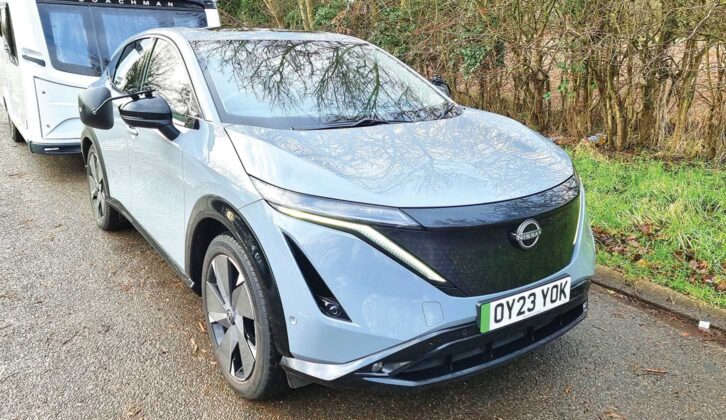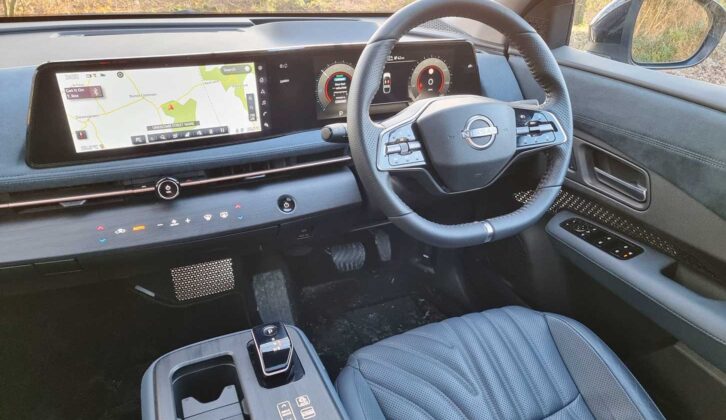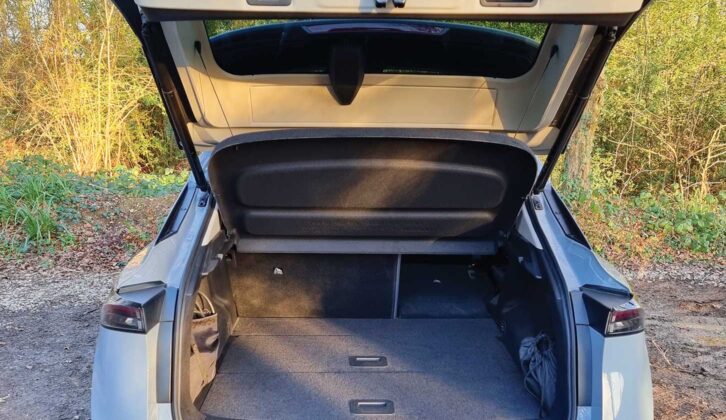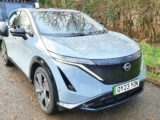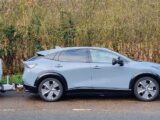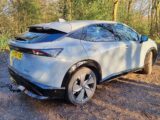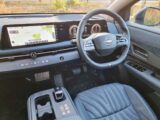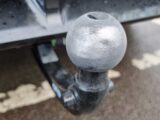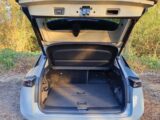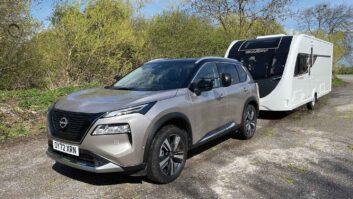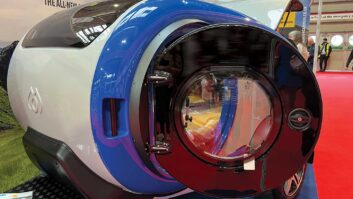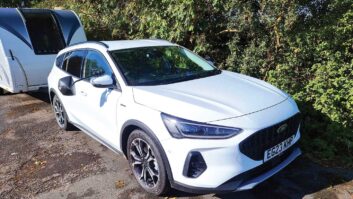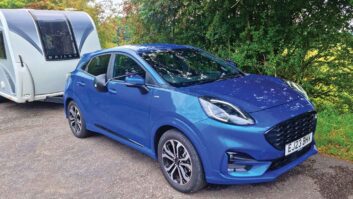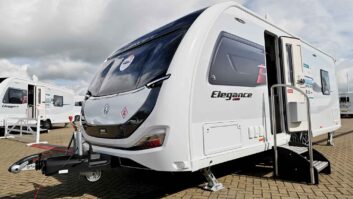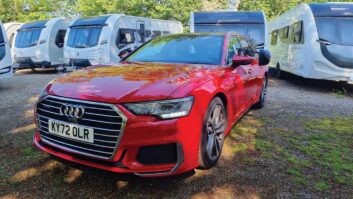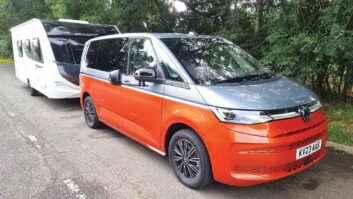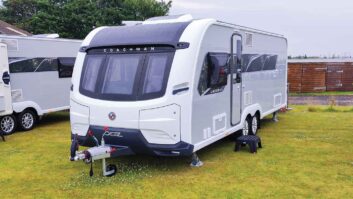Verdict
Towing long distances with any electric car takes time and planning. If you are keen to make the switch, though, the Ariya is a fine choice. More boot space would be welcome, but it is quick, stable and comfortable.
Pros
None
Cons
None
Nissan was a pioneer of electric vehicles with the Leaf. Recently, it has broadened its electric range with the Ariya. The high-powered four-wheel-drive model that we’ve been driving, the Nissan Ariya E-4orce Evolve, is approved to tow up to 1500kg.
What are we looking for in the Nissan Ariya E-4orce Evolve?
The best tow cars offer stable towing and a strong performance – we want to discover whether the Ariya does and how far it will travel between charges while towing a caravan.
Towing ability of the Nissan Ariya E-4orce Evolve
Some electric cars are heavy but hampered by low maximum towing figures. Not the Ariya. The four-wheel-drive E-4orce model can tow up to 1500kg, so plenty of family four-berths make sensible matches.
We paired the Nissan with a Coachman VIP 565 with a MiRO of 1497kg. From the first turn of the wheel, the Ariya felt at home towing the Coachman. We’ve towed with quicker electric cars, but none has felt more stable than the big Nissan.
The hefty kerbweight of 2222kg helps. Being so much heavier than the caravan, the Ariya always feels firmly in charge.
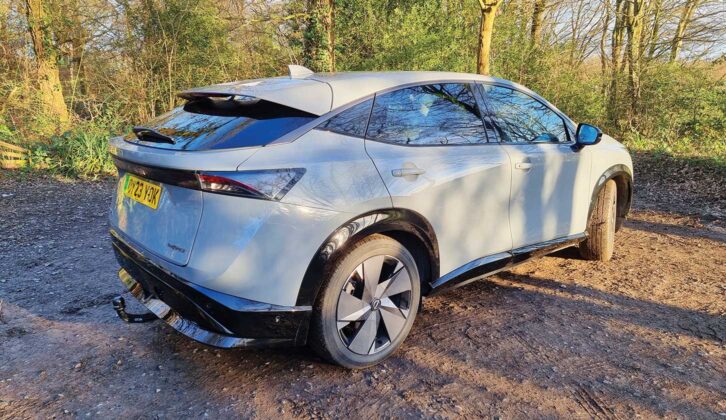
The Nissan keeps that considerable heft low to the ground, which also contributes to its stability on the road.
Breezy weather or disturbed air around HGVs hardly bothered the Nissan. It was never less than composed at motorway speeds (check out our guide to speed limits when towing a caravan if you want a refresh on these). Turning off onto country roads, the Ariya continued to impress. The suspension is quite firm, keeping body movements in check on lumpy B-roads. This in turn keeps the caravan on a short leash.
Hill starts are effortless. The Ariya pulled away decisively and without wheelspin on a damp 1-in-10 slope. With so much pulling power (443lb ft of torque) going to all four wheels, the Ariya E-4orce takes inclement weather in its stride, something people look for when searching for the best 4×4 for towing.
While it doesn’t have the punch and pace of a Genesis Electrified GV70, the Ariya accelerates briskly from a standing start, and comfortably maintains speed on hilly roads or into a stiff headwind.
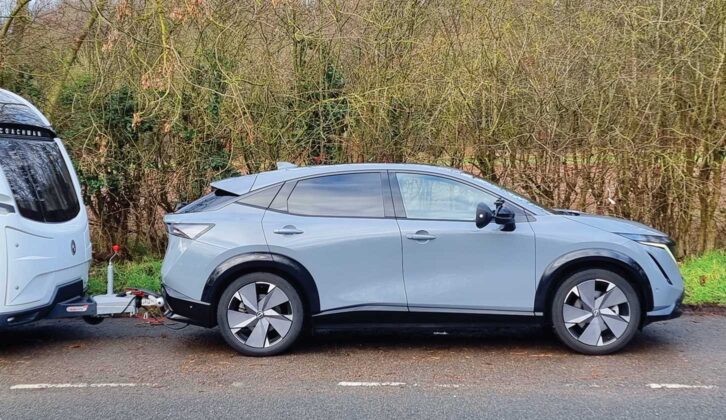
As with any electric car, the chief concerns while towing are range and the inconvenience of recharging while needing to keep the caravan secure. On a cold day, the Ariya covered 1.5 miles per kWh of electricity consumed. With a usable battery capacity of 87kWh, that gives a range while towing of around 130 miles.
That would improve in warmer weather, or while towing a lighter caravan. However, this still leaves the difficulty of recharging while needing to keep the van secure.
As we’ve written in the past, there need to be more extra-long recharging bays on motorways and other main routes, designed to accommodate electric vehicles towing caravans and trailers.
Solo driving in the Nissan Ariya E-4orce Evolve
Without the weight of a caravan, the Ariya is a rapid car, with a 0-60mph time of 5.7 seconds. Punchy acceleration is there when you need it, but the Ariya is easy to drive smoothly when you don’t. It’s just as happy edging along in stop-start traffic as hitting 70mph by the end of a motorway slip road.
E-4orce models weigh more than the two-wheel-drive versions, and the suspension has been tweaked to cope. The settings are well judged, balancing body control with acceptable comfort around town.
On country roads, the car’s pace is very impressive and the brakes do a good job of slowing down this heavy vehicle. It’s easy to judge how much pressure on the pedal is needed – not always the case with EVs.
On the motorway, the twin electric motors are barely audible, but road noise is prominent, especially over coarse surfaces.
Space and practicality in the Nissan Ariya E-4orce Evolve
The Ariya is striking inside. For the most part the standard of finish is high, with the back-lit touch-sensitive air-con controls in the wooden dash panel looking especially high-tech. Here and there, cheaper-looking plastics undermine the general impression of quality, but only slightly. Don’t forget one of the best caravan sat navs and you’ll be all set.

It’s easy to find a comfortable driving position, with a good range of adjustment to both seat and wheel. Storage is taken care of with door bins and two gloveboxes.
Rear-seat passengers will be almost as comfortable as those up front, with acres of legroom. Headroom is generous, too. The flat floor leaves space for everyone’s feet if travelling with three in the back.
Vents between the front seats supply chilled air, and there are a couple of USB chargers to keep devices topped up.
One disadvantage of choosing the Ariya 4×4 is the smaller boot compared with the two-wheel-drive models. The 408-litre capacity is some way off the 490 litres in the Kia EV6, for example. It’s easy to pack, though, as there’s no load lip. There’s space to either side for storing charging cables, although it’s a shame there isn’t room for them out of sight under the floor.
Buying and owning
The Ariya is competitively priced, given its performance, space and equipment. What’s more, What Car? magazine research suggests that discounts of several thousand pounds are possible with some arm-twisting.
Running costs will depend on where you charge – doing so at home will cost less. Don’t forget to get some good security accessories for your car too, such as the best steering wheel lock.
In Evolve specification the Nissan is well equipped. A 10-speaker stereo, heated and cooled front seats, heated rear seats, an opening panoramic sunroof and a head-up display are all fitted as standard.
See what I made of another electric option, the Genesis GV80, a well-equipped car which offers caravanners great stability.
Technical spec
- Price: £54,840
- What Car? Target Price: £50,214
- Retained value after three years: 58%
- Kerbweight: 2222kg
- 85% of kerbweight: Above max tow
- Gross vehicle weight: 2665kg
- Max towing limit: 1500kg
- Gross train weight: 4165kg
- Towball limit: 75kg
- Price of towball and electrics: £955
- Boot size: 408 litres
- Payload: 443kg
- Test conditions: Damp
- Battery size: 87kWh
- Power (hp): 388
- Torque (lb ft): 443
- Official range: 309 miles
- Towing range: 130 miles
- CO2 emissions: 0g/km
- First year car tax: £0
- Second year car tax: £0
- Insurance group: 41E
- Euro NCAP rating: 5/5
Now you’ve sorted your car, it’s time to think about how you will tow – take a look at our guide to caravan towing courses if you want to find a way to improve your technique.
Images: David Motton
If you’ve enjoyed reading this article, why not get the latest news, reviews and features delivered direct to your door or inbox every month. Take advantage of our brilliant Practical Caravan magazine SUBSCRIBERS’ OFFER and SIGN UP TO OUR NEWSLETTER for regular weekly updates on all things caravan related.
Technical Specifications
| Kerbweight | 2222 kg |
| 85% KW | Above max tow kg |
| Towball Limit | 75 kg |
| Maximum Towing Limit | 1500 kg |
| Power | 388 bhp |
| Torque | 443 lb ft |
